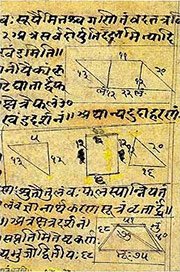Dhi, Dhī: 27 definitions
Introduction:
Dhi means something in Buddhism, Pali, Hinduism, Sanskrit, the history of ancient India, Marathi, Jainism, Prakrit. If you want to know the exact meaning, history, etymology or English translation of this term then check out the descriptions on this page. Add your comment or reference to a book if you want to contribute to this summary article.
Images (photo gallery)
In Hinduism
Natyashastra (theatrics and dramaturgy)
Source: Wisdom Library: Nāṭya-śāstraDhī (धी, “imaginative fancy”) refers to one of the twenty-one sandhyantara, or “distinct characteristics of segments (sandhi)” according to the Nāṭyaśāstra chapter 21. The segments are divisions of the plot (itivṛtta or vastu) of a dramatic play (nāṭaka) and consist of sixty-four limbs, known collectively as the sandhyaṅga.

Natyashastra (नाट्यशास्त्र, nāṭyaśāstra) refers to both the ancient Indian tradition (shastra) of performing arts, (natya—theatrics, drama, dance, music), as well as the name of a Sanskrit work dealing with these subjects. It also teaches the rules for composing Dramatic plays (nataka), construction and performance of Theater, and Poetic works (kavya).
Vyakarana (Sanskrit grammar)
Source: Wikisource: A dictionary of Sanskrit grammar1) Dhi (धि).—A technical term used for sonant consonants in the Pratisakhya and old grammar works; cf. धि शेषः (dhi śeṣaḥ) V. Pr.I.53, explained by Uvvata as वर्गाणां उत्तरास्त्रयः यरलवहकाराश्च धिः (vargāṇāṃ uttarāstrayaḥ yaralavahakārāśca dhiḥ) V.Pr. I.53; the term धि (dhi) corresponds to हश् (haś) of Panini;
2) Dhi.—Personal ending धि (dhi) substituted for हि (hi) of the impera. 2nd sing. e.g. जुहुधि, छिन्द्धि, भिन्द्धि, श्रुधि, रारन्धि (juhudhi, chinddhi, bhinddhi, śrudhi, rārandhi) etc.; cf.P.V.4.101-103.

Vyakarana (व्याकरण, vyākaraṇa) refers to Sanskrit grammar and represents one of the six additional sciences (vedanga) to be studied along with the Vedas. Vyakarana concerns itself with the rules of Sanskrit grammar and linguistic analysis in order to establish the correct context of words and sentences.
Ayurveda (science of life)
Source: archive.org: Vagbhata’s Ashtanga Hridaya Samhita (first 5 chapters)Dhī (धी) refers to “wit”, as mentioned in verse 5.37-39 of the Aṣṭāṅgahṛdayasaṃhitā (Sūtrasthāna) by Vāgbhaṭa.—Accordingly, “[...] [ghee is] recommended for wit [viz., dhī], memory, intellect, digestion, strength, longevity, sperm, eyes, [...]: ghee [viz., ghṛta] (is) possessed of a thousand powers (and), by its (many) ways of application, productive of a thousand effects”.
Note: Dhī (“wit”), smṛti (“memory”), medhā (“intellect”), and—a little later—svara (“voice”) have been specified by suitable attributes: blo rno (“sharp wit”), dran gsal (“bright memory”), yid gźuṅs (“keen intellect”), and skad sñan (“melodious voice”).
Source: gurumukhi.ru: Ayurveda glossary of termsDhī (धी):—Understanding , intelligence , wisdom

Āyurveda (आयुर्वेद, ayurveda) is a branch of Indian science dealing with medicine, herbalism, taxology, anatomy, surgery, alchemy and related topics. Traditional practice of Āyurveda in ancient India dates back to at least the first millenium BC. Literature is commonly written in Sanskrit using various poetic metres.
Shaktism (Shakta philosophy)
Source: Google Books: ManthanabhairavatantramDhī (धी) refers to the “intellect”, according to the Mahānayaprakāśa verse 2.1-35, while explaining the cycles of the goddesses of consciousness.—Accordingly, “[...] (This group of five) consists of the Void (śūnya), vital breath (prāṇa), intellect (dhī), and the senses of knowledge and action. (These together are) the body (kāya), which as an insentient, external object of the senses consists of the (five gross elements) starting with Space and ending with Earth. It is attended by perfected yogis whose foundation (ādhāra) is the experience of the infinite (anantānubhava)”.

Shakta (शाक्त, śākta) or Shaktism (śāktism) represents a tradition of Hinduism where the Goddess (Devi) is revered and worshipped. Shakta literature includes a range of scriptures, including various Agamas and Tantras, although its roots may be traced back to the Vedas.
Jyotisha (astronomy and astrology)
Source: Wisdom Library: Brihat Samhita by VarahamihiraDhī (धी) refers to “sense”, according to the Bṛhatsaṃhitā (chapter 15) (“On the nakṣatras—‘asterisms’”), an encyclopedic Sanskrit work written by Varāhamihira mainly focusing on the science of ancient Indian astronomy astronomy (Jyotiṣa).—Accordingly, “Those who are born on the lunar day of Punarvasu will be noted for truthfulness, generosity, cleanliness, respectable descent, personal beauty, sense (dhī), fame and wealth; they will also be merchants, dealing in excellent articles, will be fond of service and will delight in the company of painters and sculptors. [...]”.

Jyotisha (ज्योतिष, jyotiṣa or jyotish) refers to ‘astronomy’ or “Vedic astrology” and represents the fifth of the six Vedangas (additional sciences to be studied along with the Vedas). Jyotisha concerns itself with the study and prediction of the movements of celestial bodies, in order to calculate the auspicious time for rituals and ceremonies.
Ganitashastra (Mathematics and Algebra)
Source: archive.org: Hindu MathematicsDhī (धी) represents the number 7 (seven) in the “word-numeral system” (bhūtasaṃkhyā), which was used in Sanskrit texts dealing with astronomy, mathematics, metrics, as well as in the dates of inscriptions and manuscripts in ancient Indian literature.—A system of expressing numbers by means of words arranged as in the place-value notation was developed and perfected in India in the early centuries of the Christian era. In this system the numerals [e.g., 7—dhī] are expressed by names of things, beings or concepts, which, naturally or in accordance with the teaching of the Śāstras, connote numbers.

Ganitashastra (शिल्पशास्त्र, gaṇitaśāstra) refers to the ancient Indian science of mathematics, algebra, number theory, arithmetic, etc. Closely allied with astronomy, both were commonly taught and studied in universities, even since the 1st millennium BCE. Ganita-shastra also includes ritualistic math-books such as the Shulba-sutras.
General definition (in Hinduism)
Source: Wisdom Library: HinduismDhī (धी)—One of the eleven wives of Rudra, called a Rudrāṇī.
Source: archive.org: Vedic index of Names and SubjectsDhī (धी, ‘thought’) is used several times in the Rigveda to denote the ‘prayer’ or ‘hymn of praise’ of the singer. One poet speaks of himself as ‘weaving’ such a prayer, while another refers to his ‘ancient ancestral hymn’, which he refurbishes presumably for use.
In Buddhism
Tibetan Buddhism (Vajrayana or tantric Buddhism)
Source: Brill: Śaivism and the Tantric Traditions (tantric Buddhism)Dhī (धी) refers to a “wise man”, according to the Bhūśalyasūtrapātananimittavidhi section of Jagaddarpaṇa’s Ācāryakriyāsamuccaya, a text within Tantric Buddhism dealing with construction manual for monasteries etc.—Accordingly, “[...] If a Bhikṣu, Brāhmaṇa, wise man (dhī), or a wealthy man is seen, it brings virtue. [...]”.

Tibetan Buddhism includes schools such as Nyingma, Kadampa, Kagyu and Gelug. Their primary canon of literature is divided in two broad categories: The Kangyur, which consists of Buddha’s words, and the Tengyur, which includes commentaries from various sources. Esotericism and tantra techniques (vajrayāna) are collected indepently.
India history and geography
Source: Cologne Digital Sanskrit Dictionaries: Indian Epigraphical GlossaryDhī.—(IE 7-1-2), ‘seven’. Note: dhī is defined in the “Indian epigraphical glossary” as it can be found on ancient inscriptions commonly written in Sanskrit, Prakrit or Dravidian languages.

The history of India traces the identification of countries, villages, towns and other regions of India, as well as mythology, zoology, royal dynasties, rulers, tribes, local festivities and traditions and regional languages. Ancient India enjoyed religious freedom and encourages the path of Dharma, a concept common to Buddhism, Hinduism, and Jainism.
Languages of India and abroad
Pali-English dictionary
Source: BuddhaSasana: Concise Pali-English Dictionarydhi : (ind.) fie! shame! woe!
Source: Sutta: The Pali Text Society's Pali-English Dictionary1) Dhi, 2 (f.) (Sk. dhīḥ to didheti, cp. Av. dī to see, Goth. (filu-) deisei cunning. See also dhīra) wisdom, only in Com. expl. of paññā: “dhi vuccati paññā” (exegesis of dhīra) at Nd1 44=J.II, 140=III, 38. (Page 341)
2) Dhi, 1 & Dhī (indecl.) (Sk. dhik) an excln of reproach & disgust: fie! shame! woe! (with Acc. or Gen.) S.V, 217 (read dhī taṃ for dhītaṃ); Dh.389 (dhī=garahāmi DhA.IV, 148); J.I, 507; DhA.I, 179 (haṃ dhī), 216 (v. l. BB but text has haṃdi). An inorganic r replaces the sandhi-cons. in dhī-r-atthu jīvitaṃ Sn.440; cp. Th.I, 1150; dhi-r-atthu jātiyā J.I, 59. (Page 341)

Pali is the language of the Tipiṭaka, which is the sacred canon of Theravāda Buddhism and contains much of the Buddha’s speech. Closeley related to Sanskrit, both languages are used interchangeably between religions.
Marathi-English dictionary
Source: DDSA: The Molesworth Marathi and English Dictionarydhī (धी).—f S Understanding, intellect, mind.
Source: DDSA: The Aryabhusan school dictionary, Marathi-Englishdhī (धी).—f Understanding, intellect, mind.
Marathi is an Indo-European language having over 70 million native speakers people in (predominantly) Maharashtra India. Marathi, like many other Indo-Aryan languages, evolved from early forms of Prakrit, which itself is a subset of Sanskrit, one of the most ancient languages of the world.
Sanskrit dictionary
Source: DDSA: The practical Sanskrit-English dictionaryDhi (धि).—I. 6 P. (dhiyati) T hold, have, possess. -With सम् (sam) to make peace, treat with; cf. संधा (saṃdhā) -II. (or dhinv) 5 P. (dhinoti) To please, delight; satisfy; पश्यन्ति चात्मरूपं तदपि विलुलितस्रग्धरेयं धिनोति (paśyanti cātmarūpaṃ tadapi vilulitasragdhareyaṃ dhinoti) Gītagovinda 12; धिनोति नास्माञ्जलजेन पूजा त्वयान्वहं तन्वि वितन्यमाना (dhinoti nāsmāñjalajena pūjā tvayānvahaṃ tanvi vitanyamānā) N.8.97; Uttararāmacarita 5.27; Kirātārjunīya 1.22.
--- OR ---
Dhi (धि).—(At the end of comp. only) A receptacle store, reservoir &c.; as in उदधि, इषुधि, वारिधि, जलधि (udadhi, iṣudhi, vāridhi, jaladhi) &c.
Derivable forms: dhiḥ (धिः).
--- OR ---
Dhī (धी).—4 Ā (dhīyate)
1) To disregard, disrespect.
2) To propitiate.
3) To hold, contain.
4) To accomplish, fulfil.
--- OR ---
Dhī (धी).—[dhyai bhāve kvip saṃprasāraṇaṃ ca]
1) (a) Intellect, understanding; धियः समग्रैः स गुणैरुदारधीः (dhiyaḥ samagraiḥ sa guṇairudāradhīḥ) R.3.3; cf. कुधी, सुधी (kudhī, sudhī) &c. धियो यो नः प्रचोदयात् (dhiyo yo naḥ pracodayāt) Gāyatrimantra; तत्राज्ञानं धिया नश्येदाभासात्तु घटः स्फुरेत् (tatrājñānaṃ dhiyā naśyedābhāsāttu ghaṭaḥ sphuret) Vedāntasāra. (b) Mind; दुष्टधी (duṣṭadhī) wicked-minded; स्थितधीः किं प्रभाषेत (sthitadhīḥ kiṃ prabhāṣeta) Bhagavadgītā (Bombay) 2.54; R.3.3.
2) Idea, imagination, fancy, conception; न धियां पथि वर्तसे (na dhiyāṃ pathi vartase) Kumārasambhava 6.22; ध्यायन्ति चान्यं धिया (dhyāyanti cānyaṃ dhiyā) Pañcatantra (Bombay) 136.
3) A thought, intention, purpose, propensity; इमामहं वेद न तावकीं धियम् (imāmahaṃ veda na tāvakīṃ dhiyam) Kirātārjunīya 1.37.
4) Devotion, prayer.
5) A sacrifice.
6) Knowledge, science.
7) (in Horoscope) The fifth house from the लग्न (lagna).
Derivable forms: dhīḥ (धीः).
Source: Cologne Digital Sanskrit Dictionaries: Edgerton Buddhist Hybrid Sanskrit DictionaryDhi (धि).—interj. (= Pali id., Sanskrit dhik), fie! out upon it!: hā hā dhi muṣyanti hi (v.l. °ti mi, i.e. °ti ime) sarvasattvā Saddharmapuṇḍarīka 351.6 alas, alas, fie! for all creatures (or, all these crea- tures) are deceived (or, lost). WT read śuṣyanti; both edd. take dhi as the preverb adhi with the verb, but it is surely the interj.
Source: Cologne Digital Sanskrit Dictionaries: Shabda-Sagara Sanskrit-English DictionaryDhi (धि).—r. 6th cl. (dhiyati) To have hold, to keep, to possess. tudā0 pa0 saka0 aniṭ .
--- OR ---
Dhī (धी).—[(o ṅa) odhīṅ] r. 4th cl. (dhīyate) 1. To contain, to hold. 2. To light, to disregard or despise. 3. To accomplish. With antara, To disappear, to become invisible. divā0 ā0 saka0 aniṭ .
--- OR ---
Dhī (धी).—f.
(-dhīḥ) Understanding, intellect. E. dhyai to meditate, affix kvip, the final diphthong rejected, and the semi-vowel changed to its congener i, which becomes long. dhai-sampa-bhāve-kkip .
Source: Cologne Digital Sanskrit Dictionaries: Benfey Sanskrit-English DictionaryDhi (धि).—i. 6, [Parasmaipada.] To hold (akin to dhā).
--- OR ---
Dhi (धि).—[-dhi] (vb. dhā, form of an old ptcple, dhant, cf. ūdhan, payodhas and payodhi), latter part of comp. nouns, The receptacle for keeping that which the preceding part denotes; cf. e. g. ambu-dhi.
--- OR ---
Dhī (धी).—i. 4, [Ātmanepada.] (properly pass. of dhā), To hold, to disregard, or to accomplish.
--- OR ---
Dhī (धी).—(vb. dhyai), f. 1. Knowledge, Bhāṣāp. 45; [Mānavadharmaśāstra] 6, 92. 2. Intellect, mind, [Mānavadharmaśāstra] 12, 122. 3. Devotion,
Dhi (धि).—1. dhinoti nourish, refresh, gladden.
--- OR ---
Dhi (धि).—2. [masculine] receptacle (only —°).
--- OR ---
Dhī (धी).—1. v. dīdhī & dhyā.
--- OR ---
Dhī (धी).—2. [feminine] thought, idea, notion, intention, opinion, intelligence, wisdom, art; devotion, prayer, (often personif.).
Source: Cologne Digital Sanskrit Dictionaries: Monier-Williams Sanskrit-English Dictionary1) Dhi (धि):—1. dhi [class] 6. [Parasmaipada] dhiyati (didhāya, dheṣyati etc.) to hold ([Dhātupāṭha xxviii, 113]). Prob. formed [from] √1. dhā, of which it is the weak form.
2) 2. dhi m. receptacle (only ifc.; cf. ambu-, iṣuetc.)
3) 3. dhi or dhinv [class] 5. [Parasmaipada] dhinoti ([Aorist] adhinvīt, [Brāhmaṇa]; [perfect tense] didhinva; [future] dhinviṣyati, dhinvitā [grammar])
—to nourish, satiate, satisfy, [Brāhmaṇa];
—to delight, please, [Kāvya literature]
4) 4. dhi = adhi2 (e.g. in dhi-ṣṭhita [Mahābhārata; Bhāgavata-purāṇa] for adhi-ṣṭhita q.v.; cf. pi = api, va = ava).
5) Dhī (धी):—1. dhī [class] 3. [Ātmanepada] dīdhīte, etc., [Ṛg-veda] (cf. √dīdhī; the forms dhīmahi and adhāyi belong rather to √1. dhā; [perfect tense] dīdhaya, dhima, dhiyur or dhyur, dhire, [Ṛg-veda; Atharva-veda; Brāhmaṇa])
—to perceive, think, reflect;—wish, desire:—[Intensive] dedhyat, [Taittirīya-saṃhitā]
6) 2. dhī f. thought, ([especially]) religious thought, reflection, meditation, devotion, prayer ([plural] Holy Thoughts personified), [Ṛg-veda]
7) understanding, intelligence, wisdom (personified as the wife of Rudra-Manyu, [Bhāgavata-purāṇa]), knowledge, science, art
8) mind, disposition, intention, design (ifc. intent upon, [Kāvya literature])
9) notion, opinion, the taking for ([compound]), [Ṛg-veda] etc. etc. (yathā dhiyā or dhiyā na, according to thy wisdom or will; itthā dhiyā or dhiyaḥ, willingly [literally] such is thy will, [Ṛg-veda])
10) Name of the 5th house from the Lagna, [Varāha-mihira]
11) 3. dhī [class] 4. [Ātmanepada] dhīyate, to contain, hold ([Passive voice] of √1. dhā?);
—to slight, disregard;
—to propitiate (?), [Dhātupāṭha xxvi, 37.]
12) 4. dhī f. for dī, splendour, [Ṛg-veda iii, 34, 5; vi, 3, 3.]
Source: Cologne Digital Sanskrit Dictionaries: Yates Sanskrit-English Dictionary1) Dhi (धि):—(śa) dhiyati 6. a. To have, to keep or hold or possess. (na) dhinoti 5. a. To satisfy; to go.
2) Dhī (धी):—(ya, ṅa, o) dhīyate 4. d. To contain; to slight; to accomplish.
3) (dhīḥ) 3. f. Understanding.
Source: DDSA: Paia-sadda-mahannavo; a comprehensive Prakrit Hindi dictionary (S)Dhī (धी) in the Sanskrit language is related to the Prakrit word: Dhī.
[Sanskrit to German]
Sanskrit, also spelled संस्कृतम् (saṃskṛtam), is an ancient language of India commonly seen as the grandmother of the Indo-European language family (even English!). Closely allied with Prakrit and Pali, Sanskrit is more exhaustive in both grammar and terms and has the most extensive collection of literature in the world, greatly surpassing its sister-languages Greek and Latin.
Prakrit-English dictionary
Source: DDSA: Paia-sadda-mahannavo; a comprehensive Prakrit Hindi dictionary1) Dhi (धि) in the Prakrit language is related to the Sanskrit word: Dhik.
2) Dhī (धी) also relates to the Sanskrit word: Dhī.
3) Dhī (धी) also relates to the Sanskrit word: Dhik.
Prakrit is an ancient language closely associated with both Pali and Sanskrit. Jain literature is often composed in this language or sub-dialects, such as the Agamas and their commentaries which are written in Ardhamagadhi and Maharashtri Prakrit. The earliest extant texts can be dated to as early as the 4th century BCE although core portions might be older.
Kannada-English dictionary
Source: Alar: Kannada-English corpusDhī (ಧೀ):—[noun] the ability to a) learn or understand from experience, b) acquire and retain knowledge, and c) respond quickly and successfully to a new situation, d) think and act rationally and wisely; intelligence; wisdom.
Kannada is a Dravidian language (as opposed to the Indo-European language family) mainly spoken in the southwestern region of India.
See also (Relevant definitions)
Starts with (+1924): Dhi-chitrak, Dhia, Dhibadi, Dhibari, Dhibri, Dhida, Dhiddhasa, Dhiddho, Dhidhana, Dhidhara, Dhidhi, Dhidhini, Dhidi, Dhidla, Dhidyarobhindaro, Dhig, Dhiga, Dhigadhiga, Dhigama, Dhigara.
Ends with (+4987): A sa gandhi, A swa gandhi, A-campirannatacamati, A-karpaviputi, A-swa-ga-ndhi, Aadhaadhi, Abadhi, Abandhi, Abbhimtaruddhi, Abbudi, Abdhi, Abhibuddhi, Abhidhi, Abhididhi, Abhimatasiddhi, Abhinavacandrarghavidhi, Abhinavachandrarghavidhi, Abhiraddhi, Abhisambodhi, Abhisandhi.
Full-text (+778): Udaradhi, Kritadhi, Sthuladhi, Sthitadhi, Nyunadhi, Shuddhadhi, Alpadhi, Arishtadushtadhi, Sudhi, Anurodhin, Toyadhi, Udadhi, Kilaladhi, Ambudhi, Duradhi, Ambhodhi, Parvadhi, Ishudhi, Pathodhi, Payodhi.
Relevant text
Search found 79 books and stories containing Dhi, Dhī; (plurals include: Dhis, Dhīs). You can also click to the full overview containing English textual excerpts. Below are direct links for the most relevant articles:
Rig Veda (translation and commentary) (by H. H. Wilson)
Manusmriti with the Commentary of Medhatithi (by Ganganatha Jha)
Verse 6.92 < [Section VIII - The Renouncer of the Veda (vedasaṃnyāsika)]
Verse 2.104 < [Section XIX - Twilight Prayers]
Verse 1.21 < [Section IX - Creation of the World from ‘Mahat’ downwards]
Jivanandana of Anandaraya Makhin (Study) (by G. D. Jayalakshmi)
The concept of Jñāna and Vijñāna (Śarmā and Śarma) < [Chapter 5 - Advaitic principles in Jīvanandana Nāṭaka]
Advaitic aspects of Act VII < [Chapter 5 - Advaitic principles in Jīvanandana Nāṭaka]
Analysis of Śānta-rasa < [Chapter 6 - Dramatic aspects of the Jīvanandana Nāṭaka]
Garga Samhita (English) (by Danavir Goswami)
Verse 4.19.86 < [Chapter 19 - A Thousand Names of Srī Yamunā]
Verse 6.10.34 < [Chapter 10 - In the Description of the Gomatī River, the Glories of Cakra-tīrtha]
Verse 2.17.28 < [Chapter 17 - The Meeting of Śrī Rādhā-Kṛṣṇa]
Bhakti-rasamrta-sindhu (by Śrīla Rūpa Gosvāmī)
Verse 2.5.69 < [Part 5 - Permanent Ecstatic Mood (sthāyī-bhāva)]
Verse 2.3.26 < [Part 3 - Involuntary Ecstatic Expressions (sattvika-bhāva)]
Verse 2.5.35 < [Part 5 - Permanent Ecstatic Mood (sthāyī-bhāva)]
The Devi Bhagavata Purana (by Swami Vijñanananda)

